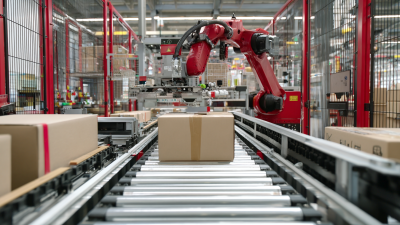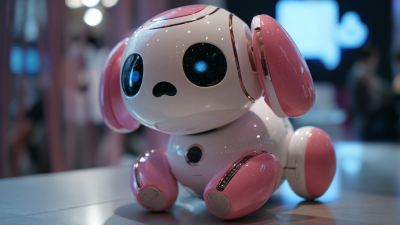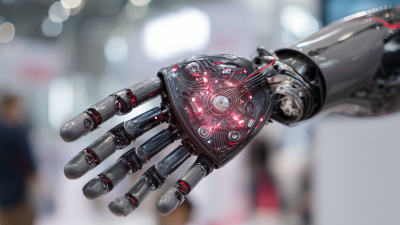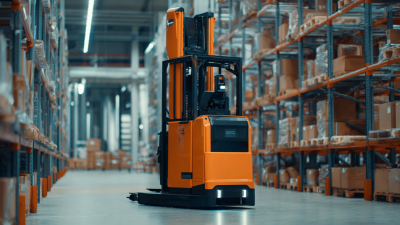The Future of Logistics How Palletizing Robots are Transforming Warehouse Efficiency
In the rapidly evolving world of logistics, automation is becoming a cornerstone of operational efficiency. Among the innovations making waves in warehouse management are palletizing robots, which are designed to streamline the palletizing process, reduce labor costs, and improve overall productivity. According to a report by MarketsandMarkets, the global logistics automation market is expected to reach $74.93 billion by 2026, with palletizing robots playing a significant role in this growth. These automated systems enhance accuracy and speed, reducing the potential for human error and freeing up human workers for more complex tasks. As industries increasingly adopt advanced technologies to meet the demands of fast-paced supply chain environments, palletizing robots represent a transformative solution for companies seeking to optimize their logistics operations. Embracing this technology not only boosts efficiency but also aligns with the broader trends of sustainability and cost-effectiveness that are reshaping the future of warehousing.

The Rise of Palletizing Robots in Modern Warehousing
The rise of palletizing robots in modern warehousing is revolutionizing the way products are handled and distributed. As e-commerce continues to grow, the demand for efficiency and speed in logistics has never been higher. Palletizing robots streamline the stacking and organizing of goods, significantly reducing manual labor and the risk of workplace injuries. These advanced machines not only enhance operational efficiency but also improve accuracy in order fulfillment.
- Assess Your Needs: Before integrating palletizing robots, evaluate the specific requirements of your warehouse operations. Consider factors like layout, product types, and volume to choose the right robot model.
- Invest in Training: Proper training for staff on how to operate and maintain palletizing robots is crucial. This will ensure that the technology is utilized effectively, maximizing its potential for efficiency.
- Monitor and Adapt: Regularly review the performance of your palletizing robots and be open to adjustments. Continuous monitoring can help identify areas for improvement and enable your warehouse to adapt to changing demands.
As companies embrace automation, the integration of palletizing robots is not just a trend; it’s becoming an essential component of competitive warehousing strategies. The future of logistics is here, and it’s powered by robotics.
Enhancing Operational Efficiency through Automated Solutions
Automated solutions in logistics are revolutionizing warehouse operations, significantly enhancing operational efficiency. Palletizing robots, in particular, stand at the forefront of this transformation. By automating the process of stacking and organizing goods, these robots reduce manual labor and the potential for human error. This ensures a more streamlined operation where products can be processed and shipped more quickly, leading to faster turnaround times and improved order accuracy.
Furthermore, the integration of palletizing robots with advanced technologies, such as artificial intelligence and machine learning, allows for smarter decision-making within warehouse environments. These robots can assess various factors, such as weight and dimensions of goods, to optimize stacking patterns and space utilization. As a result, warehouses can maximize their storage capabilities while minimizing the risk of damage to products. Overall, the deployment of automated solutions like palletizing robots is setting new standards in logistics, driving efficiency and productivity to unprecedented levels.
The Future of Logistics: How Palletizing Robots are Transforming Warehouse Efficiency
The chart above illustrates the increasing trend in warehouse efficiency resulting from the adoption of palletizing robots over the years. As automation solutions are implemented, there is a noticeable rise in operational efficiency, highlighting the transformative impact of technology in logistics.
Integrating AI and Machine Learning for Smarter Logistics
The integration of AI and machine learning into palletizing robots is revolutionizing the logistics sector, significantly enhancing warehouse efficiency. By leveraging advanced algorithms, these robots can learn from their environment and adapt their operations in real-time. This not only optimizes the packing process but also minimizes errors during item handling, leading to higher productivity and reduced operational costs. The ability to analyze vast amounts of data enables these machines to predict demand patterns, allowing for smarter inventory management strategies.

Furthermore, AI-driven palletizing robots can collaborate with other automated systems, creating a seamless workflow throughout the warehouse. This integration fosters enhanced communication between different robotic systems, ensuring that tasks such as sorting, transporting, and packing are executed with a high degree of accuracy. As a result, warehouses become more agile, responding quickly to changes in consumer demand and market dynamics. With the continuous advancements in artificial intelligence and machine learning, the future of logistics promises to be not only more efficient but also more resilient, paving the way for innovative supply chain solutions.
Reducing Labor Costs and Increasing Safety with Robotics
The integration of palletizing robots in warehouses is revolutionizing the logistics sector, particularly in terms of reducing labor costs and enhancing safety. Traditionally, palletizing was a labor-intensive task, often leading to high wage bills and increasing the risk of workplace injuries.
 With the advent of robotics, companies can automate this critical function, significantly cutting down on labor expenses. This technology streamlines the handling of goods, allowing businesses to allocate their human resources to more complex tasks that require critical thinking and creativity.
With the advent of robotics, companies can automate this critical function, significantly cutting down on labor expenses. This technology streamlines the handling of goods, allowing businesses to allocate their human resources to more complex tasks that require critical thinking and creativity.
In addition to economic benefits, palletizing robots contribute to a safer working environment. These machines are designed to handle heavy loads and repetitive movements, which are common causes of workplace injuries. By taking over physically demanding tasks, robots reduce the strain on human workers, leading to fewer accidents and healthier employees. Enhanced safety protocols around automated systems also minimize the risk of errors that could result in damage to products or equipment, which further supports operational efficiency. Overall, the adoption of palletizing robots not only drives down costs but also fosters a safer and more productive warehouse atmosphere.
Future Trends: The Evolution of Warehouse Automation Technologies
The evolution of warehouse automation technologies is rapidly reshaping the logistics landscape, with palletizing robots at the forefront of this transformation. These sophisticated machines not only enhance efficiency but also bring a new level of precision to the packing and shipping processes. By automating the repetitive task of palletizing, warehouses can reduce labor costs and minimize human error, leading to faster turnaround times and improved order accuracy. The integration of advanced sensors and artificial intelligence allows these robots to adapt to various product sizes and weights, making them versatile tools in a dynamic warehouse environment.
As the demand for faster delivery times grows, the future of warehouse automation will continue to evolve. Emerging technologies such as autonomous mobile robots (AMRs) and machine learning algorithms are set to complement palletizing systems, enhancing overall operational efficiency. These innovations promise to streamline inventory management and order fulfillment processes, setting a new standard for performance in logistics. The focus on seamless integration and scalability will empower warehouses to respond effortlessly to fluctuating market demands and consumer expectations, marking a significant shift in the industry's approach to automation.
The Future of Logistics: How Palletizing Robots are Transforming Warehouse Efficiency
| Aspect | Current Trends | Future Predictions |
|---|---|---|
| Automation Level | 60% Automation | 85% Automation by 2025 |
| Labor Cost Savings | 25% Reduction | 50% Reduction Expected |
| Robot Adoption Rate | 35% of Facilities | 80% of Facilities by 2030 |
| Efficiency Increase | 20% Improvement | 40% Improvement by 2025 |
| Challenge Areas | Integration Issues | Enhanced Interoperability Solutions |
Related Posts
-

Transforming Logistics: Cobot Palletizers at the 138th Canton Fair 2025 – Industry Insights and Innovations
-

Unleashing Digital Transformation: The Ultimate Guide to Robotic Process Automation Software
-

Unlocking the Future of Work with Robotic Process Automation for Everyday Tasks
-

Discover the Future of Companionship: How Robot Pets are Changing Lives
-

Exploring Robotic Process Automation Tools at the 2025 China 138th Canton Fair Insights and Innovations
-

Revolutionizing Supply Chains: How Warehouse Robots Are Shaping the Future of Logistics
Smart Robotics brand movie
Watch video


